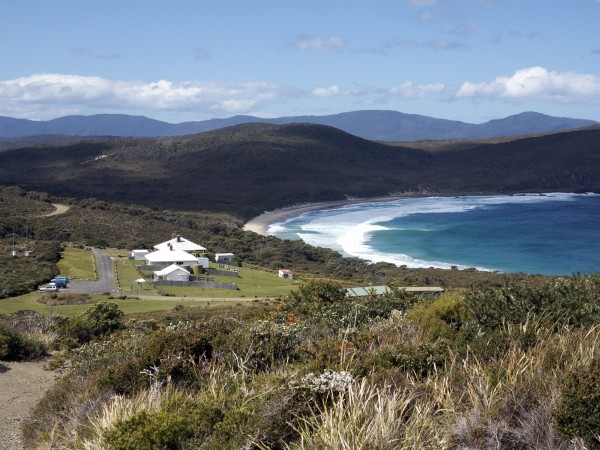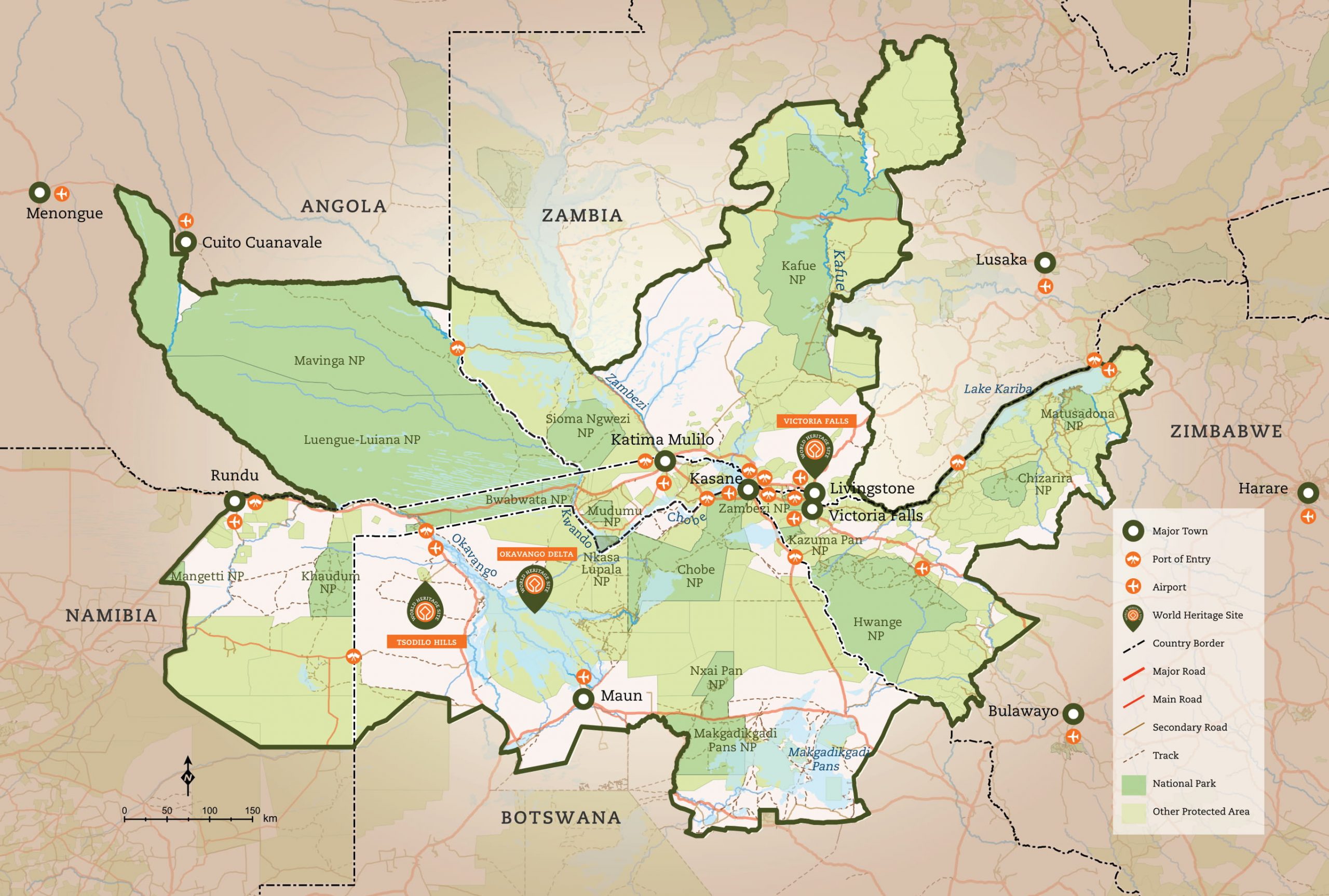

Background to Transfrontier Conservation Areas (TFCAs) in the Southern African Development Community (SADC)
There are 18 Transfrontier Conservation Areas (TFCAs) in the Southern African development Community (SADC) region. They are in terrestrial and marine environments and are at various stages of development. SADC TFCAs were founded on the realisation that natural resources straddling boundaries between Member States are shared assets with substantial potential to meaningfully contribute towards biodiversity conservation with special emphasis on sustainable wildlife management, the socio-economic development of rural communities living in and around them, and importantly, regional integration. Their configuration varies from those that are Transfrontier Parks (TP) that include two or more adjacent and protected areas, to those that include a complexity of land-uses such as communal land, concession areas and Protected Areas. Kavango Zambezi Transfrontier Conservation Area (KAZA TFCA) is a notable example of the latter.
About Kavango Zambezi Transfrontier Conservation Area (KAZA TFCA)
KAZA TFCA, commonly known as KAZA, is the world’s largest TFCA at approximately 520,000km². The cornerstone of KAZA was laid on 7th December 2006 when the ministers responsible for environment, natural resources, wildlife and tourism in the Republics of Angola, Botswana, Namibia, Zambia and Zimbabwe signed a Memorandum of Understanding to work towards the establishment of the TFCA. The Treaty formally establishing KAZA TFCA was signed in Luanda, Angola, in August 2011. This set the stage for a regionally integrated approach towards harmonizing policies, strategies, and practices for managing the shared natural resources straddling the international borders of KAZA’s five Partner States. This regional integration approach aims to derive equitable socio-economic benefits through the sustainable use and development of their natural and cultural heritage resources.
Occupying part of the Okavango and Zambezi river basins, KAZA encompasses areas within the borders of KAZA’s Partner States, the TFCA includes 36 formally proclaimed protected areas made up of a host of game reserves, forest reserves, game/wildlife management areas, and communal lands. Some of these protected areas have designated concessions for non-consumptive tourism development.
KAZA is endowed with a wide range of species diversity – flora and fauna. There are more than 3,000 plant species throughout the TFCA, of which 100 are endemic to the sub-region. KAZA also caters to large-scale migrations of megafauna, hosting the largest contiguous population of African elephant on the continent, making the African elephant a flagship species of the TFCA. KAZA is key conservation area for threatened species such as the lion, cheetah, and African wild dog, of which an estimated one quarter of the population is found in the TFCA. Over 600 bird species have been identified, as well as 128 reptile species and 50 amphibian species.
Importantly, KAZA is home to renowned tourism destinations of the Southern African region including Chobe National Park, Hwange National Park, Kafue National Park, and the Makgadikgadi Pans. The TFCA is also home to the Victoria Falls, a natural and cultural UNESCO World Heritage Site (mixed WHS), and one of the Seven Natural Wonders of the World. KAZA harbors two additional mixed WHS – the Okavango Delta, and Tsodilo Hills.
An estimated 2,5 to 3 million people live in KAZA across its five Partner States, mainly in rural areas. Through cultural heritage tourism and employment opportunities presented by the tourism value chain, KAZA Partner States aim to enhance the participation of these rural communities in the tourism economy not only through their provision of tourism-related goods and services, but also through celebration and nourishment of the region’s rich cultural diversity. This is achievable through facilitating the sharing of age-old knowledge and traditions by rural communities across borders not only with each other, but with the world at large.
The goal of KAZA is to sustainably manage the region’s landscape and cultural heritage based on best-practice conservation and tourism models that also consider the socio-economic wellbeing of the communities and other stakeholders. This goal is cognizant of the strong interdependency between KAZA and the tourism sector.
On the one hand, KAZA TFCA is an ideal platform for promoting regional tourism integration and growth in Southern Africa, thereby contributing towards to employment creation, economic diversification, regional integration, and poverty reduction in rural and remote areas adjacent to its major tourism attractions. Transboundary tourism development in the KAZA region and its surrounds also has substantial potential to contribute to increased livelihood options for local and rural populations, and to reducing the pressure on exploitation of the natural and cultural assets within it. Conversely, the tourism sector is the largest market-based contributor to financing many protected areas in KAZA, with the tourism industry in KAZA being almost exclusively dependent on healthy natural and cultural systems, often with wildlife as the primary attraction.
To tap into the potential that tourism has to offer, with respect to achieving KAZA TFCA’s development goals and objectives, bottlenecks to effective and sustainable cross border tourism development in the KAZA region must be removed. The collaborative planning and implementation of interventions among the five Partner Sates has been an important component of KAZA’s transboundary tourism development agenda. A ‘whole-of-government’ approach, meaning public service agencies working across portfolio boundaries, is essential to address bottlenecks affecting the ease of movement of tourists to and within the KAZA region. A few examples are provided below.
Evidenced sustainable tourism operations in the KAZA TFCA region
The identification and profiling of tourism products (accommodation, activities and attractions) that have been audited and approved for sustainability certification status – providing tour operators with an opportunity to easily identify those businesses with this important unique selling proposition when designing itineraries in the KAZA region. This was an intervention implemented in partnership with KAZA and FUTOURIS, a non-profit initiative of the German tourism industry aimed at supporting sustainable development initiatives, with a focus on biodiversity conservation, climate protection, sociocultural responsibility, and poverty reduction. For more information visit: https://www.futouris.org/en/kaza-map-sustainable-lodges/ and http://www.futouris.org/en/projects/kaza-sustainable-lodges/. A list of sustainable lodges in KAZA TFCA last updated as recently as March 2020 can be viewed here: https://www.futouris.org/wp-content/uploads/KAZA-Sustainable-Lodges-March-2020_eng.pdf/
Partner States working together to profile and market a single yet multi-faceted international tourism destination
Historically, tourism marketing among SADC TFCA Partner Countries has largely centered around a single country model based on the political boundaries of the region’s Member States, with each country competing for its market share by using various promotion strategies to attract visitors. As called for by KAZA Partner State Ministers in 2019, the KAZA region requires marketing and investment promotion interventions that go beyond conventional marketing and towards market development which focuses on both supply and demand sides, and that adds value to the tourism experience in a manner that expands the benefits of tourism to more than one country. This approach is intended to complement individual Partner Country efforts, while diversifying SADC’s tourism offerings through capitalizing on the region’s natural and cultural heritage assets and contributing to socio-economic growth
To this end, KAZA Secretariat, the entity mandated with coordination and facilitation for the regional development of KAZA, with the support of German Development Cooperation and in close collaboration with Partner States, developed a tourism destination profile brochure in September 2020. The brochure, entitled “A journey through KAZA TFCA” profiles KAZA’s biodiversity and cultural heritage story and expansive tourism offerings (accommodation, activities, attractions, and cultural heritage encounters). Development partners across the five Partner States included tourism ministries, national and regional destination marketing organisations, wildlife and parks officials and, critically, the tourism private sector. The brochure has been confirmed as effectively packaging KAZA as a distinct, multi-faceted and attractive international tourism destination.
The brochure, which includes a tourism map, will primarily be leveraged for business-to-business communication and marketing efforts, constituting a fundamental resource for regional and international tour planners (travel trade and independent travelers) to use to plan or assess potential for the development of air and ground travel itineraries. The brochure can be viewed here: https://www.sadc.int/files/2615/9974/4830/KAZA_Brochure.pdf.
A whole of government approach towards reducing bottlenecks to the ease of tourist movement to and within the KAZA TFCA region
Southern Africa is not an easy and self-explanatory destination for the average uniformed tourist. Regulations affecting travel to and within the region are critically and negatively impacting the tourism sector. These include entry and visa requirements, as well as inefficient, cumbersome and unharmonized border crossing costs and requirements. Overcoming barriers to tourist travel to and within the region will open limitless potential and opportunities with respect to regional integration, an increase in travel to and within the region, and an increase in tourism investment by private sector actors.
To this end, and with support from German Development Cooperation, a KAZA UNIVISA initiative was established with the overarching goal of improving the value and volume of travelers to and within KAZA. The KAZA UNIVISA pilotphase was launched in November 2014, between Zambia and Zimbabwe. In the two years that followed the initiative underwent several development stages. In December 2016, Zambia and Zimbabwe launched the rollout phase of the KAZA UNIVISA, in Livingstone Zambia. The Ministers of Home Affairs from both Zambia and Zimbabwe signed a Memorandum of Understanding symbolizing commencement of the permanent issuance of a KAZA UNIVIS. While the roll out to all five Partner States is at internal consultation stages with respect to the remaining three Partner States, the KAZA UNIVSIA remains fully operational between Zambia and Zimbabwe. For more information visit: https://www.kavangozambezi.org/en/information/tourist-visa.
Realizing that TFCAs have common challenges, and in line with the SADC TFCA vision, TFCA international coordinators, several international NGOs and TFCA practitioners from ten SADC Member States founded the SADC TFCA Network in September 2013 in Johannesburg, South Africa. KAZA TFCA is an active member of this network and leverages this platform, amongst others, to share knowledge and experiences with other TFCAs in the Southern African region.
The founding members of the TFCA Network agreed that the TFCA Network will strive “to overcome TFCA challenges through shared learning, knowledge management and collaboration”, by improving information exchange, joint learning and knowledge management, resource mobilisation, and collaboration and partnerships.
To date, the network comprises of more than 500 members representing various stakeholders, including the TFCA Focal Points for each SADC Member State, TFCA International Coordinators, international and regional NGOs, international cooperating partners, private sector, academia representatives. It receives support from a broad range of partner organizations and programmes, among them the African Wildlife Foundation, Boundless Southern Africa, Frankfurt Zoological Society, IUCN BIOPAMA Programme, Panthera, Peace Parks Foundation, USAID RESILIM and SAREP Programmes, WWF and the German Development Cooperation through GIZ and KfW. The Network also intends to broaden membership to involve community representative and traditional leaders. For more information on the network visit: https://tfcaportal.org/.
Additionally, KAZA TFCA shares information on initiatives and developments on its website. For more information visit: https://www.kavangozambezi.org.
© Linking Tourism & Conservation (LT&C) 2019
We are grateful that you support the work and mission of LT&C! We accept donations through Credit Card, PayPal or international bank transfer:

Donate through Credit Card
Please click the Donate button and then choose your PayPal account
Bank details:
Cultura Sparebank
Pb. 6800, St. Olavs plass
N-0130 Oslo
Name: Linking Tourism & Conservation,
Account no.: 1254 05 95168
IBAN: NO8712540595168
BIC/SWIFT: CULTNOK1
Routing BIC: DNBANOKK
Please mark payments with your name and/or email address
Sign up for an LT&C membership by filling in the details below.
Would you like your LT&C-Example/Initiative to be listed on our website? Please fill in the form below.